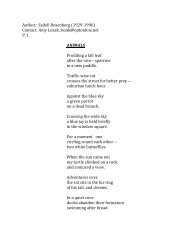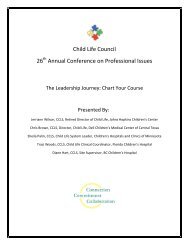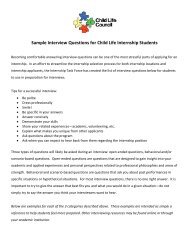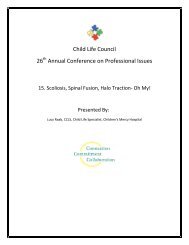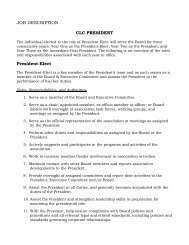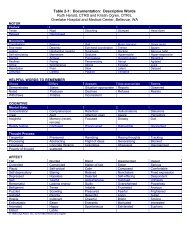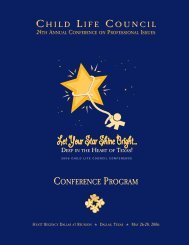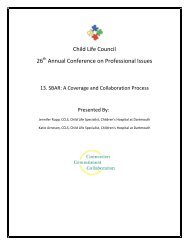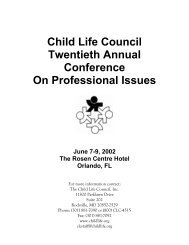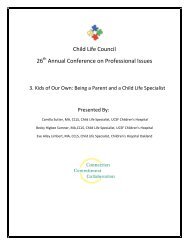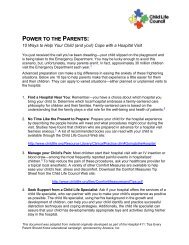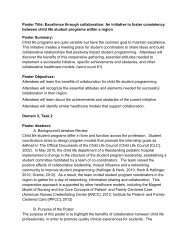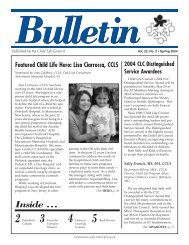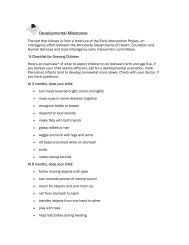The Role of Child Life in Pediatric Pain ... - Child Life Council
The Role of Child Life in Pediatric Pain ... - Child Life Council
The Role of Child Life in Pediatric Pain ... - Child Life Council
Create successful ePaper yourself
Turn your PDF publications into a flip-book with our unique Google optimized e-Paper software.
<strong>Child</strong> <strong>Life</strong> <strong>Council</strong><br />
26 th Annual Conference on Pr<strong>of</strong>essional Issues<br />
14. <strong>The</strong> <strong>Role</strong> <strong>of</strong> <strong>Child</strong> <strong>Life</strong> <strong>in</strong> <strong>Pediatric</strong> Pa<strong>in</strong> Management:<br />
Research F<strong>in</strong>d<strong>in</strong>gs and Implications<br />
Presented By:<br />
Chantal LeBlanc, CCLS, <strong>Child</strong> <strong>Life</strong> Specialist, IWK Health Centre<br />
Ellen Hollon, CCLS, Director, <strong>Child</strong> <strong>Life</strong> Department, <strong>Child</strong>ren's Medical Center Dallas
<strong>The</strong> <strong>Role</strong> <strong>of</strong> <strong>Child</strong> <strong>Life</strong> <strong>in</strong><br />
<strong>Pediatric</strong> Pa<strong>in</strong> Management:<br />
Research F<strong>in</strong>d<strong>in</strong>gs and Implications<br />
Presenters: Chantal LeBlanc & Ellen Hollon<br />
Research Investigators: Nancy Bandstra, L<strong>in</strong>da Sk<strong>in</strong>ner,<br />
Chantal LeBlanc, Christ<strong>in</strong>e Chambers, Debbie Brennan and<br />
Chantal Beaver<br />
Rationale for the Study<br />
1. Need for current research describ<strong>in</strong>g<br />
strategies used by CLS<br />
2. <strong>The</strong> stage was already set at the IWK:<br />
� Personal <strong>in</strong>terest <strong>in</strong> child life<br />
� IWK CLS <strong>in</strong>terested <strong>in</strong> research<br />
� CLS <strong>in</strong> North America <strong>in</strong>terested <strong>in</strong> research<br />
<strong>The</strong> Truths <strong>of</strong> <strong>Pediatric</strong> Pa<strong>in</strong><br />
� Inadequately treated pa<strong>in</strong> can lead to longterm<br />
negative consequences<br />
� Strong evidence for non-pharmacological<br />
approaches<br />
� <strong>Child</strong>ren cont<strong>in</strong>ue to be undertreated for<br />
their pa<strong>in</strong><br />
Tra<strong>in</strong><strong>in</strong>g Health Pr<strong>of</strong>essionals<br />
� Empirical evidence available<br />
� Translat<strong>in</strong>g evidence � practice<br />
� Review <strong>of</strong> pa<strong>in</strong> mgt. tra<strong>in</strong><strong>in</strong>g programs<br />
(MacLaren & Cohen, 2005)<br />
� a variety <strong>of</strong> tra<strong>in</strong>ees<br />
� shifts <strong>in</strong> knowledge & attitudes<br />
� Interdiscipl<strong>in</strong>ary teams
General Research: <strong>Child</strong> <strong>Life</strong><br />
� Primary goal is to reduce anxiety and<br />
distress (Ricks & Faubert, 1981; Mather &<br />
Glasrud, 1981; Gaynard, Hausslem, & DeMarsh,<br />
1989)<br />
� Provider <strong>of</strong> non-pharmacological<br />
techniques (Doellman, 2003)<br />
Objectives <strong>of</strong> the Study<br />
� To describe the strategies currently used<br />
� To describe the efficacy <strong>of</strong> strategies<br />
� To determ<strong>in</strong>e level <strong>of</strong> past tra<strong>in</strong><strong>in</strong>g and to<br />
assess level <strong>of</strong> <strong>in</strong>terest <strong>in</strong> future tra<strong>in</strong><strong>in</strong>g<br />
Survey Items<br />
� Placed <strong>in</strong>to 1 <strong>of</strong> 4 categories:<br />
1. Behavioural<br />
2. Cognitive<br />
3. Complementary<br />
4. Physical<br />
� Rated by experts for empirical support:<br />
1. Strong Support<br />
2. Moderate/Mixed Support<br />
3. Not Effective<br />
4. No research / Not familiar with lit…<br />
<strong>Child</strong> <strong>Life</strong> <strong>in</strong> the<br />
Emergency Department<br />
� ED research suggests beneficial services <strong>in</strong><br />
the area <strong>of</strong> pa<strong>in</strong> management (Krebel et al.,<br />
1996)<br />
� patients recover faster<br />
� patients require less pa<strong>in</strong> medication<br />
Survey Development<br />
� Interdiscipl<strong>in</strong>ary research team<br />
� pediatric pa<strong>in</strong> researchers<br />
� child life specialists<br />
� Survey items reviewed by:<br />
� 3 experts <strong>in</strong> pediatric pa<strong>in</strong><br />
� 5 child life specialists<br />
� 2 graduate students<br />
� Onl<strong>in</strong>e version completed by research team<br />
� 2006 <strong>Child</strong> <strong>Life</strong> <strong>Council</strong> Directory<br />
� limited to hospital-based programs<br />
Recruitment<br />
� sent to all listed programs <strong>in</strong> US and Canada<br />
� Notification <strong>of</strong> survey sent to directors<br />
� Survey <strong>in</strong> English or French (Canada only)
Onl<strong>in</strong>e Participation<br />
� Participants responded to an onl<strong>in</strong>e survey<br />
� Required ~ 25 m<strong>in</strong>utes to complete<br />
� A donation <strong>of</strong> $2 (per participant) was<br />
made <strong>in</strong> honour <strong>of</strong> participation<br />
Obta<strong>in</strong><strong>in</strong>g Consent Onl<strong>in</strong>e<br />
� Becom<strong>in</strong>g more common<br />
� Little difference between whether<br />
participants gave <strong>in</strong>formed consent onl<strong>in</strong>e<br />
or <strong>in</strong> a face-to-face paper distribution<br />
method (Varnhagen et al., 2005)<br />
� Participants encountered the follow<strong>in</strong>g:<br />
If you agree to participate, please click the<br />
“I agree to participate” button below.<br />
<strong>The</strong> Onl<strong>in</strong>e Survey <strong>The</strong> Onl<strong>in</strong>e Survey (cont<strong>in</strong>ued…)<br />
<strong>The</strong> Onl<strong>in</strong>e Survey (cont<strong>in</strong>ued…) <strong>The</strong> Onl<strong>in</strong>e Survey (cont<strong>in</strong>ued…)
Results<br />
� Approximately 400 <strong>in</strong>stitutions contacted<br />
(39 <strong>in</strong> Canada, 363 <strong>in</strong> US)<br />
� 14 <strong>in</strong>stitutions unable to be contacted<br />
� 711 child life specialists contacted <strong>in</strong> total<br />
� 607 responded<br />
� response rate � 85.4%<br />
General Education & Tra<strong>in</strong><strong>in</strong>g<br />
� Highest level <strong>of</strong> completed education<br />
� University/College Graduate = 59.2%<br />
� Graduate School / Pr<strong>of</strong>. Tra<strong>in</strong><strong>in</strong>g = 37.2%<br />
� 84.2% reported be<strong>in</strong>g certified CLS<br />
Descriptive Analyses<br />
� 97.4% female<br />
Participants<br />
� Average age: 34.1 years (SD = 9.60)<br />
� 18.1% (110) from Canada; 81.9% (497)<br />
from US<br />
� Reported work<strong>in</strong>g an average <strong>of</strong> 8.6 years<br />
(SD = 7.69) <strong>in</strong> the child life pr<strong>of</strong>ession<br />
Pa<strong>in</strong> Tra<strong>in</strong><strong>in</strong>g & Experience<br />
� 66.1% reported tra<strong>in</strong><strong>in</strong>g <strong>in</strong> pa<strong>in</strong> mgt.<br />
� 65.0% reported provid<strong>in</strong>g pa<strong>in</strong> mgt.<br />
services to >50% <strong>of</strong> their patients<br />
� Most respondents rated their knowledge<br />
(52.9%) & skill (54.4%) as ‘good’<br />
� Far fewer rated their knowledge (8.9%) &<br />
skill (9.7%) as ‘excellent’<br />
QUESTION:<br />
Frequency <strong>of</strong> Use<br />
� “How <strong>of</strong>ten do you use [strategy] to<br />
manage a child’s pa<strong>in</strong>?<br />
SCALE:<br />
� 1 = never<br />
� 2 = rarely<br />
� 3 = sometimes<br />
� 4 = very <strong>of</strong>ten<br />
� 5 = always
Mean Frequency <strong>of</strong> Use<br />
5<br />
4<br />
3<br />
2<br />
1<br />
Mean Frequency <strong>of</strong> Use<br />
5<br />
4<br />
3<br />
2<br />
1<br />
Spot Pressure / Coun...<br />
Go<strong>in</strong>g for a drive…<br />
Experts report on the evidence for each strategy<br />
Red = Not Effective<br />
Yellow<br />
= Some/Mixed Support<br />
Green = Strong Support<br />
Massage<br />
Cognitive Strategies<br />
Virtual Reality<br />
Hypnosis<br />
Thought-Stopp<strong>in</strong>g<br />
PMR<br />
Memory Change<br />
Cop<strong>in</strong>g Self-Statements<br />
Relaxation Tra<strong>in</strong><strong>in</strong>g<br />
Imagery<br />
Suggestion<br />
Cognitive Distraction<br />
Breath<strong>in</strong>g Exercises<br />
Comfort<strong>in</strong>g / Reassurance<br />
Preparation / Information<br />
Physical Strategies<br />
Heal<strong>in</strong>g / <strong>The</strong>rapeuti...<br />
Heat / Cold <strong>The</strong>rapy<br />
Comfort Position<strong>in</strong>g<br />
Mean Frequency <strong>of</strong> Use<br />
Mean Frequency <strong>of</strong> Use<br />
5<br />
4<br />
3<br />
2<br />
1<br />
5<br />
4<br />
3<br />
2<br />
1<br />
Art<br />
MOST:<br />
� Prep/Info<br />
� Reassurance<br />
Behavioural Strategies<br />
Model<strong>in</strong>g<br />
Medical Staff Coach<strong>in</strong>g<br />
Desensitization<br />
Parent Tra<strong>in</strong><strong>in</strong>g<br />
Rehearsal<br />
Parent Coach<strong>in</strong>g<br />
Behavioural Distraction<br />
Positive Re<strong>in</strong>forcement<br />
Complementary Strategies<br />
Music<br />
� + Re<strong>in</strong>forcement<br />
� Beh. Distraction<br />
� <strong>The</strong>rapeutic Play<br />
Medical Play<br />
Play<br />
Frequency <strong>of</strong> Use<br />
LEAST:<br />
� Virtual Reality<br />
� Hypnosis<br />
� Spot Pressure…<br />
� Thought-Stopp<strong>in</strong>g<br />
� PMR<br />
� Massage<br />
� HT/TT<br />
� Memory Change
� 70% cut-<strong>of</strong>f<br />
Perceived Effectiveness<br />
� 8 strategies did not meet this %<br />
� Heal<strong>in</strong>g/<strong>The</strong>rapeutic Touch<br />
� Hypnosis<br />
� Massage<br />
� Memory Change<br />
� Progressive Muscle Relaxation<br />
� Spot-Pressure/Counter-Irritation<br />
� Thought Stopp<strong>in</strong>g<br />
� Virtual Reality<br />
MOST:<br />
� Prep/Info<br />
� Medical Play<br />
� <strong>The</strong>rapeutic Play<br />
Tra<strong>in</strong><strong>in</strong>g Received<br />
LEAST:<br />
� Virtual Reality<br />
� Spot Pressure…<br />
� Hypnosis<br />
� Thought-Stopp<strong>in</strong>g<br />
� Memory Change<br />
� Massage<br />
� HT/TT<br />
� PMR<br />
Predict<strong>in</strong>g the Use <strong>of</strong><br />
Empirically Supported Strategies<br />
Perceived Effectiveness (cont’d)<br />
MOST:<br />
� Prep/Info<br />
LEAST:<br />
� Cop<strong>in</strong>g Self-Statements<br />
� Medical Staff Coach<strong>in</strong>g<br />
� Heat/Cold <strong>The</strong>rapy<br />
Interest <strong>in</strong> Future Tra<strong>in</strong><strong>in</strong>g<br />
� High levels <strong>of</strong> <strong>in</strong>terest <strong>in</strong> receiv<strong>in</strong>g future<br />
tra<strong>in</strong><strong>in</strong>g <strong>in</strong> all <strong>of</strong> the strategies:<br />
� High End: Desensitization - 94.7%<br />
� Low End: Hypnosis - 79.1%<br />
Primary Outcome - Frequency<br />
� Used experts’ rat<strong>in</strong>gs to weight strategies:<br />
Red = Not Effective (0 pts)<br />
Yellow<br />
= Some/Mixed Support (1 pt)<br />
Green = Strong Support (2 pts)<br />
� Calculated a total score for each participant<br />
� e.g., hypnosis (2) + imagery (1) = 3<br />
� Total possible score �29 pts
Multiple Regression Analysis<br />
� To predict use <strong>of</strong> Empirically-Supported<br />
Treatments (criterion variable)<br />
� Predictor variables<br />
� age, US/Canada<br />
� certification, level <strong>of</strong> education<br />
� proportion <strong>of</strong> patients who are provided pa<strong>in</strong><br />
mgt. services, skill, knowledge<br />
Multiple Regression: Results<br />
Predictor Variable<br />
Step 1<br />
Beta p<br />
Age .050 .244<br />
US/Canada<br />
Step 2<br />
-.001 .977<br />
Certification .144 .001<br />
Education<br />
Step 3<br />
.077 .073<br />
Proportion .245 .000<br />
Skill .111 .049<br />
Knowledge .164 .003<br />
Note: Adjusted R2 =.185, F7,567 = 19.63, p < .001<br />
STRENGTHS<br />
Strengths & Weaknesses<br />
� North American sample<br />
� High response rate<br />
� suggests good external validity<br />
WEAKNESSES<br />
� Self-Report Measure<br />
� subjective<br />
� retrospective<br />
� Order <strong>of</strong> questionnaire<br />
Multiple Regression: Results<br />
Predictor Variable<br />
Step 1<br />
Beta p<br />
Age .050 .244<br />
US/Canada<br />
Step 2<br />
-.001 .977<br />
Certification .144 .001<br />
Education<br />
Step 3<br />
.077 .073<br />
Proportion .245 .000<br />
Skill .111 .049<br />
Knowledge .164 .003<br />
Note: Adjusted R2 =.185, F7,567 = 19.63, p < .001<br />
Take-Home Messages<br />
� CLS are <strong>in</strong>volved <strong>in</strong> pa<strong>in</strong> management<br />
� Several predictors <strong>of</strong> the use <strong>of</strong> evidence-based<br />
strategies<br />
� Goals should be to:<br />
� require certification<br />
� target knowledge & skill<br />
� Appropriate to more formally <strong>in</strong>clude CLS <strong>in</strong><br />
pediatric pa<strong>in</strong> teams<br />
Future Directions<br />
� Observational Research<br />
� What do CLS actually do <strong>in</strong> practice?<br />
� Is the comfort/reassurance CLS provide different than<br />
<strong>in</strong> the literature?<br />
� Research to assess future priorities as<br />
determ<strong>in</strong>ed by CLS<br />
� Randomized Trials<br />
� e.g., therapeutic use <strong>of</strong> art/ play, medical play
Implications for Practice<br />
� <strong>Child</strong> life specialists are <strong>in</strong>terested &<br />
motivated to learn more<br />
�? need for ongo<strong>in</strong>g tra<strong>in</strong><strong>in</strong>g opportunities<br />
for cl<strong>in</strong>icians<br />
� Review <strong>of</strong> academic and <strong>in</strong>ternship tra<strong>in</strong><strong>in</strong>g<br />
(MacLaren & Cohen, 2005)<br />
� tra<strong>in</strong><strong>in</strong>g may be an effective method<br />
� implications for students and practic<strong>in</strong>g pr<strong>of</strong>.<br />
� some evidence for long-term effects<br />
Discussion<br />
� Multidiscipl<strong>in</strong>ary focus <strong>of</strong> pediatric pa<strong>in</strong><br />
management<br />
� Where are the boundaries?<br />
� Are there limits on what should be<br />
encouraged (e.g., CLS do<strong>in</strong>g hypnosis?)<br />
� Are there positives to be ga<strong>in</strong>ed? Are<br />
there negative consequences?<br />
�Questions?<br />
�Comments?<br />
Thank You!<br />
Implications for Practice<br />
� CLS use strategies that need further<br />
research to validate their use<br />
� <strong>The</strong>rapeutic play<br />
� Comfort<strong>in</strong>g and reassurance<br />
� <strong>The</strong>rapeutic use <strong>of</strong> art<br />
� Medical play<br />
� Position<strong>in</strong>g for comfort<br />
� Correlation between Certification and use<br />
<strong>of</strong> evidence based strategies<br />
Acknowledgments<br />
� Nancy Bandstra<br />
� L<strong>in</strong>da Sk<strong>in</strong>ner and the IWK <strong>Child</strong> <strong>Life</strong> staff<br />
� Dr. Christ<strong>in</strong>e Chambers<br />
� <strong>Pediatric</strong> Pa<strong>in</strong> Experts<br />
� Marie-Claude Grégoire



